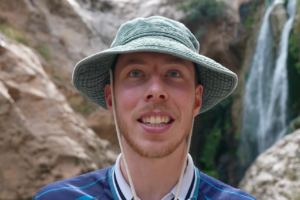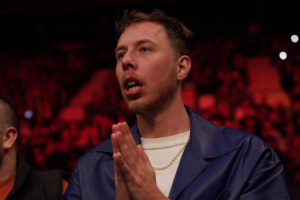In an era where digital transformation has reshaped every facet of entertainment, Cal Freezy’s journey from bedroom gamer to podcast mogul exemplifies a fascinating evolution in content creation. Like the Renaissance painters who began as apprentices mixing pigments before mastering their craft, today’s digital entrepreneurs often start with humble beginnings—recording gameplay footage and commentary—before painting on a broader canvas of media innovation.
The year 2009, when Cal uploaded his first YouTube video, marked a pivotal moment in digital content history. YouTube was still finding its footing, dominated by what Cal describes as “cat videos and gaming videos.” This era, often referred to as the “Wild West” of content creation, presented creators with both unprecedented opportunities and challenges. Without established monetization pathways or business models, early creators like Cal were driven purely by passion—a trait that would later prove invaluable in building sustainable media enterprises.
Cal’s trajectory mirrors the broader transformation of digital content creation from hobby to industry. Just as early television pioneers had to invent the grammar of broadcast entertainment, Cal and his contemporaries helped establish the language of digital content. His evolution from Call of Duty commentator to the architect of a £15 million podcast network reflects the industry’s maturation from user-generated content to professional media production.
The Fellas Studios, Cal’s podcast production company, represents more than just business success—it symbolizes the democratization of media production. Traditional barriers to entry in broadcasting, such as expensive equipment and industry connections, have been replaced by what Cal demonstrates as the essential modern currencies: authenticity, adaptability, and strategic vision. His approach to content creation, following personal interests from gaming to football to podcast production, illustrates a fundamental truth about sustainable success in digital media: authentic passion resonates more powerfully than calculated market positioning.

Perhaps most tellingly, Cal’s story challenges the conventional wisdom about digital success. While many creators chase viral moments or algorithm trends, Cal’s journey emphasizes the value of long-term vision and infrastructure building. His decision to invest in professional set design—collaborating with Star Wars studio craftsmen—demonstrates an understanding that quality and production value remain paramount, even in an age of instant content.
This evolution from content creator to media entrepreneur represents a broader shift in digital entertainment. Just as early Hollywood transitioned from nickelodeons to studio systems, we’re witnessing the professionalization of digital content creation. Cal’s success suggests that the future belongs not to solo creators but to those who can build sustainable ecosystems that nurture and amplify multiple voices while maintaining creative authenticity.
The story of Cal Freezy and The Fellas Studios serves as both inspiration and blueprint for aspiring content creators. It demonstrates that in the digital age, the path to success isn’t just about creating content—it’s about building platforms that enable others to create, connect, and flourish. This transformation from creator to enabler marks a new chapter in the evolution of digital media, one where individual success becomes a foundation for collective growth.
In an age where adaptability is currency, Cal Freezy’s international upbringing reads like a masterclass in cultural fluency. Moving between the ancient streets of Egypt, the dramatic landscapes of Russia, and the bustling energy of Vietnam, young Cal unconsciously developed what would become his greatest asset: the ability to connect with anyone, anywhere, at any time.
The international schools that dotted his childhood landscape served as informal laboratories for developing social intelligence. Unlike his peers who could rely on established friendship circles in their hometowns, Cal had to master the art of quick connection. “You have to make friends quickly,” he reflects, describing the delicate dance of entering new social circles every few years. This perpetual state of renewal would later prove invaluable in an industry where authentic connection is the cornerstone of success.
2009 marked a pivotal moment in both Cal’s life and the broader digital landscape. While YouTube was still finding its footing—a platform dominated by cat videos and gaming content—Cal began uploading Call of Duty gameplay footage. There was no roadmap to success; monetization didn’t exist, and the term “content creator” had yet to enter the cultural lexicon. This era of digital pioneering required a particular kind of courage: the willingness to create without guarantee of reward.
The arrival of Google AdSense transformed casual creators into potential entrepreneurs, though the early returns were modest by today’s standards. Cal’s first payment of £200 represented more than just pocket money—it was validation of a new career path. While his peers were stocking shelves at Tesco, Cal was laying the foundation for what would become a digital empire, one video at a time.
Perhaps the most telling aspect of Cal’s early career was his intuitive understanding of authentic content creation. As his interests evolved from gaming to football, his content naturally followed suit. This organic transition demonstrates a fundamental truth about sustainable success in digital media: authenticity cannot be manufactured. In an industry often criticized for its calculated approach to engagement, Cal’s willingness to let his content evolve with his passions set him apart.

The value of his international upbringing became increasingly apparent as his platform grew. The social adaptability developed in international schools translated perfectly to the digital age, where creators must connect with diverse, global audiences. His experience navigating different cultural contexts provided an innate understanding of universal human connection—a skill that would prove invaluable in building The Fellas Studios.
What makes Cal’s origin story particularly relevant for aspiring creators is its emphasis on foundational skills over technical expertise. While many focus on mastering algorithms or perfecting production values, Cal’s success suggests that the ability to forge genuine connections—whether in a Russian schoolyard or through a YouTube video—remains the ultimate differentiator in digital media.
His journey from international student to content pioneer offers a compelling blueprint for success in the digital age: start with authenticity, build genuine connections, and let your content evolve naturally with your interests. In an industry often fixated on quick wins and viral moments, Cal’s story reminds us that sustainable success is built on the fundamental human ability to connect, adapt, and grow.
In the spring of 2020, as the world retreated indoors and digital connection became our primary lifeline, a peculiar phenomenon emerged: the lockdown podcast boom. While countless creators rushed to share their unfiltered thoughts with kitchen walls, Cal Freezy and his co-host Chip envisioned something markedly different. Their approach would ultimately reshape the landscape of British podcasting, transforming a medium traditionally dominated by audio into a visual feast.
The genesis of The Fellas Podcast reveals a fundamental truth about creative partnerships: sometimes, the most powerful collaborations begin with resistance. For two years, Cal had pursued Chip to co-host a podcast, meeting consistent reluctance. Then came the unexpected 9:30 AM phone call—unusual for someone who typically emerged at noon—that would change everything. Chip’s condition was simple yet revolutionary: they would build a custom set.
This stipulation, which might have deterred others, led to an extraordinary partnership with Matt, a set designer whose portfolio included Star Wars productions. In an industry where many podcasters settle for ring lights and blank walls, The Fellas ventured into the realm of cinematic production. The initial £6,000 investment in a custom-built bar set—secured through what Cal describes as a “passion project” pricing—would prove transformative.
The spatial constraints of their first studio paint a vivid picture of early ambition meeting practical limitations. The set filled the room so completely that their producer had to press record and flatten himself against the wall during recordings. These tight quarters, rather than hampering creativity, fostered an intimacy that translated powerfully to viewers and listeners alike.
The Fellas’ approach to podcast production mirrors the evolution of television in the 1950s, when visionary producers realized that radio formats needed reinvention for the visual medium. Similarly, Cal and Chip understood that in an era of TikTok and Instagram, podcast content needed to be not just heard but seen. Their investment in visual quality wasn’t merely aesthetic—it was strategic, enabling content to be repurposed across platforms and reaching audiences who might never seek out traditional podcast formats.
Within three months, the podcast’s success validated their unorthodox approach. The custom set became more than a backdrop; it became a character in its own right, creating an atmosphere that distinguished The Fellas from the sea of lockdown content. This visual element proved particularly crucial as social media platforms evolved to favor video content, allowing them to create compelling clips that drove discovery and engagement.

The evolution from YouTube creator to podcast innovator wasn’t just about changing mediums—it was about elevating the entire format. As Cal notes, “We saw the way video podcasting was going.” This foresight led them to invest in production quality at a time when most podcasters focused solely on audio. The result was a hybrid format that satisfied both traditional podcast listeners and viewers accustomed to higher production values.
The Fellas Podcast’s rise illustrates a crucial lesson in content creation: sometimes, the most significant innovations come not from reinventing the wheel but from reimagining how it looks. By bringing cinematic production values to podcasting, they didn’t just create a show—they established a new standard for what digital content could be. Their journey from lockdown experiment to visual revolution serves as a blueprint for creators looking to stand out in an increasingly crowded digital landscape.
In the elegant chaos of digital media evolution, The Fellas Studios stands as a testament to thoughtful scaling—a masterclass in transforming personal success into a platform for collective growth. What began as a modest team of three has blossomed into a thriving ecosystem of 34 professionals, orchestrating a network of 12-14 podcasts that are reshaping the British media landscape.
The studio’s growth trajectory offers a compelling counterpoint to the traditional media expansion model. Rather than pursuing rapid scaling at the expense of quality, Cal Freezy’s approach embodies what management theorist Jim Collins termed “the genius of the AND”—maintaining intimate creative control while building institutional capability. The result is a network that feels less like a corporate entity and more like a creative collective, each podcast maintaining its distinct voice while benefiting from shared expertise and resources.
At the heart of The Fellas Studios’ success lies what Cal calls the “shared destiny model”—a revolutionary approach to talent partnerships that stands in stark contrast to traditional media contracts. Rather than offering creators fixed guarantees that cap their potential earnings, the studio implements a profit-sharing structure that aligns everyone’s interests. “If you’re willing to trust and really believe in you as a podcaster,” Cal explains, “the potential is so much higher.”
This philosophy extends to talent selection, where the studio has developed a nuanced approach that looks beyond raw numbers. The team evaluates potential partners through three critical lenses:
First, they assess podcasting aptitude—not just current skill, but potential for growth. “This is a learned skill,” Cal emphasizes, acknowledging his own evolution from talking over guests to masterful conversation navigation. This humility-infused perspective allows the studio to identify diamonds in the rough.
Second, they examine audience engagement quality over quantity. In an era where viral moments can create the illusion of connection, The Fellas Studios seeks creators who have built genuine communities. They understand that podcasting success requires more than views—it demands loyalty and trust.
Third, and perhaps most crucially, they evaluate authentic passion for the medium. The studio has learned to distinguish between creators genuinely driven to podcast and those merely chasing trending opportunities. As Cal notes, “Unless you are actually going to invest your time and you care about the numbers… you’re probably in it for the wrong reasons.”
The studio’s expansion from a small team to a media powerhouse hasn’t been without its challenges. Cal openly acknowledges the impostor syndrome that accompanies leading a growing organization, particularly without traditional business experience. Yet this very vulnerability has become a strength, fostering an environment where experimentation and authentic growth are celebrated.

What sets The Fellas Studios apart is their commitment to building infrastructure that serves creators rather than constraining them. Every investment in technology, talent, or resources is made with a single question in mind: How does this enhance our creators’ ability to connect with their audience?
This approach has created a virtuous cycle: successful creators attract more talent, which enables greater investment in production quality and support services, which in turn leads to better content and larger audiences. It’s a model that proves media companies can be both profitable and creator-centric, challenging the industry’s often-adversarial relationship between talent and management.
The Fellas Studios’ story suggests that the future of media lies not in traditional hierarchical structures but in collaborative ecosystems where success is measured by the rising tide that lifts all boats. It’s a vision that’s as much about community as it is about content, as much about shared growth as individual achievement.
In the ever-evolving landscape of digital media, where conventional wisdom often proves fleeting, The Fellas Studios has orchestrated a masterful pivot in content strategy and monetization. Their approach, anchored in video-first podcasting and multi-platform distribution, offers a compelling blueprint for modern media success—one that prioritizes long-term value over quick wins, and viewer satisfaction over vanity metrics.
The studio’s emphasis on video podcasting represents more than a mere format choice; it’s a strategic revolution in content monetization. While traditional podcasters focus solely on audio advertising revenue, The Fellas Studios has created a sophisticated dual-stream model. “Video opens up another revenue stream,” Cal explains, highlighting how this approach has dramatically increased year-on-year revenue. This visual element isn’t merely supplementary—it’s transformative, enabling content to be repurposed across platforms and reaching audiences who might never engage with traditional podcast formats.
Perhaps most striking is the studio’s development of an in-house advertising team, a move that challenges industry conventions. Rather than relying solely on third-party agencies, they’ve built internal expertise in video podcast advertising—a niche they recognized as underserved in the market. This decision, implemented in late 2023, has already yielded substantial returns, with Cal noting significant increases in revenue compared to previous years.
The studio’s perspective on metrics and success measurement offers particular insight into modern content strategy. While many creators remain fixated on traditional metrics like thumbnail click-through rates, The Fellas Studios prioritizes viewer satisfaction—a more nuanced and ultimately more valuable metric. As Cal astutely observes, “YouTube really values viewer satisfaction… people are when they finish this video or whenever they get to whatever point in it, they’re leaving this video happy.”
This focus on satisfaction over sensation has profound implications for content creation. Unlike clickbait strategies that might drive initial views but ultimately disappoint audiences, The Fellas Studios optimizes for long-term engagement. “You have to start thinking about how this video is going to perform in a year,” Cal emphasizes, “not how’s this going to do in the first 24 hours.”
Their approach to social media integration demonstrates equal sophistication. Understanding that platforms like Apple Podcast and Spotify offer limited discovery capabilities, the studio leverages social media—particularly TikTok and Instagram—as primary discovery channels. They’ve mastered the art of creating “clipboard content”: short, engaging segments that serve as gateways to full episodes.
The monetization strategy extends beyond traditional advertising to include innovative partnership models. Rather than accepting standard industry deals that might cap potential earnings, the studio has pioneered flexible arrangements that align incentives between creators and the platform. This approach has enabled them to achieve “three to four times” their previous revenue from traditional deals.
What makes The Fellas Studios’ strategy particularly compelling is its scalability and adaptability. Their model isn’t built on temporary platform advantages or algorithmic quirks, but on fundamental principles of audience engagement and value creation. By focusing on viewer satisfaction, developing multiple revenue streams, and maintaining control over advertising relationships, they’ve created a sustainable framework for long-term success in digital media.
The results speak volumes: a thriving network of podcasts, growing revenue streams, and most importantly, engaged audiences who return episode after episode. It’s a testament to the power of prioritizing genuine value creation over short-term metrics—a lesson that resonates far beyond the podcasting industry.
In an era where leadership narratives often read like carefully curated LinkedIn posts, Cal Freezy’s approach to building and leading The Fellas Studios offers a refreshingly authentic perspective on modern business leadership. His journey from content creator to media executive illuminates the delicate balance between maintaining creative authenticity and scaling a business—all while navigating the persistent whispers of imposter syndrome.

“My entire life has just been imposter syndrome,” Cal admits with disarming candor. In a business culture that often celebrates unwavering confidence, his openness about self-doubt feels revolutionary. Yet this very vulnerability has become a cornerstone of his leadership style, creating an environment where experimentation and genuine growth aren’t just permitted but celebrated. It raises an intriguing question: What if imposter syndrome, rather than being a weakness to overcome, serves as a catalyst for innovation?
Cal’s perspective on this psychological phenomenon is particularly enlightening: “If you don’t feel imposter syndrome, are you actually doing something new? Are you actually challenging yourself?” This reframing transforms self-doubt from a burden into a benchmark for growth—a signal that you’re pushing beyond comfortable boundaries into uncharted territory.
The studio’s decision to leave their lucrative Spotify deal exemplifies this philosophy in action. While many would have clung to the security of guaranteed income, Cal and his team chose the uncertain path of independence. This wasn’t merely a business decision; it was a declaration of values. “The money is great,” Cal reflects, “but we’re still going to be able to pay our bills if we don’t earn any money off this podcast.” This financial perspective enabled bold creative choices that prioritized long-term vision over short-term security.
Their emphasis on passion over profit manifests in every aspect of operations, from content creation to talent selection. When evaluating potential podcasters, the studio actively screens out those merely chasing trends or financial opportunities. They seek creators who demonstrate genuine enthusiasm for the medium—individuals who feel “a little bit gutted” when an episode underperforms and genuinely excited when content resonates with audiences.
Investment in production quality serves as another testament to this philosophy. While many digital media companies chase scale through cost-cutting, The Fellas Studios consistently reinvests in enhancing production values and developing team capabilities. This commitment has grown their staff from a handful of creatives to a team of 34 professionals, each contributing to the studio’s evolution.
Perhaps most telling is their approach to talent development. Rather than expecting immediate expertise, they view podcasting as a learned skill—one that requires patience, practice, and supportive guidance. Cal openly acknowledges his own growth journey, from talking over guests in early episodes to developing more refined interviewing techniques. This recognition of development as a process rather than a destination creates an environment where authentic growth can flourish.
The studio’s leadership philosophy challenges conventional wisdom about what it means to be a successful media executive. Instead of projecting infallibility, Cal and his team embrace uncertainty as a source of strength. Rather than maximizing short-term profits, they optimize for sustainable creative excellence. In doing so, they’ve created not just a successful business but a new model for leadership in the digital age—one that values authenticity over artifice, growth over certainty, and purpose over profit.
This approach suggests that perhaps the most effective business leaders aren’t those who have all the answers, but those who remain curious enough to keep asking questions. In the rapidly evolving landscape of digital media, this combination of humility and vision may prove to be the most sustainable competitive advantage of all.
In the grand narrative of digital media’s evolution, Cal Freezy’s journey from bedroom gamer to architect of a multi-million-pound podcast empire stands as both inspiration and instruction. His story transcends the typical creator-to-entrepreneur trajectory, offering deeper insights into the future of media, the value of authentic connection, and the art of sustainable innovation.
The transformation of The Fellas Studios from a lockdown experiment to the UK’s fastest-growing podcast network illuminates several crucial principles that resonate across the creative industries. First among these is the power of authentic evolution—Cal’s progression from gaming content to football videos to podcast production followed his genuine interests rather than market trends. This organic growth strategy, while perhaps slower than chasing viral moments, has proven more sustainable and satisfying.
His approach to production value—exemplified by the bold decision to invest in professional set design during the network’s early days—challenges the minimal viable product mindset prevalent in digital media. By partnering with a Star Wars studio set designer, Cal demonstrated that quality shouldn’t be sacrificed at the altar of rapid scaling. This commitment to excellence has become a defining characteristic of The Fellas Studios, setting new standards for video podcast production.
Perhaps most significantly, Cal’s leadership style offers a refreshing counterpoint to the tech industry’s culture of projected certainty. His candid acknowledgment of imposter syndrome and emphasis on continuous learning creates an environment where authenticity thrives. This vulnerability-as-strength approach has enabled the studio to attract and nurture talent who prioritize genuine connection over manufactured engagement.
The studio’s innovative “shared destiny” business model represents a potential future for creator economics—one where success is collective rather than zero-sum. By aligning incentives between platform and creator, they’ve developed a framework that could revolutionize how digital media companies approach talent partnerships.
As we look to the future of digital media, Cal’s journey suggests that success will increasingly belong to those who can balance creative authenticity with business acumen, high production values with scalability, and individual vision with collective growth. His story reminds us that in an industry obsessed with metrics and algorithms, the most powerful currency remains genuine human connection.
For aspiring creators and media entrepreneurs, the lesson is clear: sustainable success in digital media isn’t built on tricks or trends, but on authentic passion, strategic innovation, and an unwavering commitment to quality. As Cal’s journey demonstrates, the future belongs not to those who chase the algorithm, but to those who dare to set new standards while remaining true to their creative vision.


